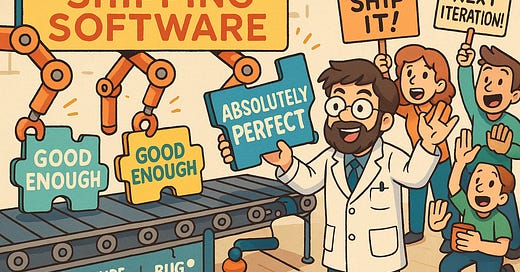The Power of "Good Enough"
(Disclaimer: This isn’t a license to embrace sloppy work. It’s about recognizing that sometimes, “perfect” is the enemy of “pretty darn good”—and that’s often where real progress lives.)
Good Enough: The Fifth Force of the Universe?
We all know the four fundamental forces—gravity, electromagnetism, strong, and weak nuclear forces. But I’d argue there’s a fifth force quietly shaping our software world: The Power of Good Enough.
This isn’t about laziness or half-baked deliverables. It’s about iterative progress—knowing when to refine, when to ship, and when to say, “We’ll improve this in the next iteration.” It’s that subtle difference between constant scope creep and actually delivering something that works. Understanding Good Enough can mean the difference between a product that ships versus one that’s perpetually “two weeks away from release.”
The MVP: Good Enough in Action
Look no further than the MVP (Minimum Viable Product) for the ultimate example of Good Enough. You don’t aim for a perfect product; you aim for just enough functionality to learn from real users and refine your idea. You start small, gather feedback, and build on it—rather than spending months or years polishing a feature nobody wants.
Fun fact: Some of the greatest success stories in tech began as tiny MVPs. They were far from perfect, but they were Good Enough to gather data, iterate quickly, and become the products we can’t live without today.
When Good Enough Outranks “Better”
Ever wonder why your company continues to use a “suboptimal” system, even when you’ve seen a shinier, fancier alternative out there? Chances are, the old system is simply Good Enough to meet current objectives. The cost (in time, money, and risk) to replace it isn’t justified by the potential gains—at least not right now.
“But there’s a more elegant solution!”
“We could automate half our processes with some next-gen AI!”
Sure, that might be true. But if the existing system is Good Enough to get the job done, there’s no urgent business case to upend everything. We constantly weigh what we could do against what we should do.
My Brush With “Almost Genius” (and Why It Flopped)
I once went on a crusade to automatically detect duplicate bugs using a machine learning model. Think text embeddings, image comparisons, and a neural net that performed almost as well as a human. It was downright futuristic… for 2022, anyway.
But guess what? Maintaining and retraining that model turned out to be way more hassle than it was worth. Manually marking duplicates? Not glamorous, but Good Enough to achieve the goal. The fancy ML solution was cool tech, but it didn’t actually solve the problem in a way that was cost-effective or easy to maintain.
Making “Good Enough” Your Ally
Accepting Good Enough isn’t about settling for mediocrity. It’s about:
Knowing where to invest your energy and resources.
Continuously iterating small improvements instead of holding out for perfection.
Recognizing when a solution already meets the need, so you can focus on higher-impact work elsewhere.
I’ve stopped treating Good Enough like the enemy of my big ideas. Instead, I see it as a guide—a feedback loop that tells me where my time is best spent. If something is legitimately Good Enough, fantastic. Move on to where your brilliance is truly needed.
From Good Enough to Awesome
And here’s the real kicker: “Awesome” is often the result of incremental improvements layered on top of Good Enough solutions over time. It’s not always one giant leap; it’s a series of small steps that evolve a product from usable to extraordinary.
So the next time you catch yourself thinking, “This is just Good Enough,” don’t apologize for it. Ship it, learn from it, and keep going. If you’re consistent, that string of Good Enough’s might just add up to something brilliant.
(And hey, maybe one day we’ll officially recognize “Good Enough” as the fifth fundamental force. I can dream, right?)




